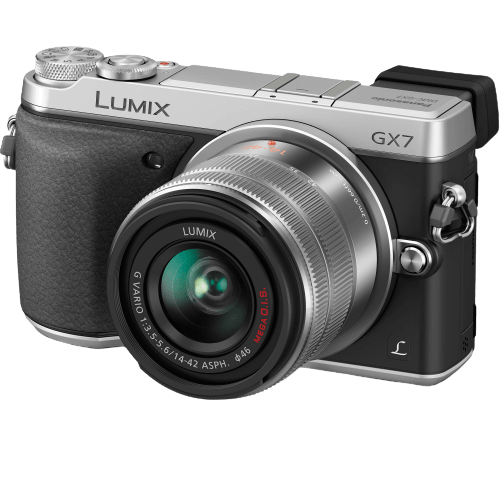Panasonic Lumix DMC-GX7 Specs and Scores

The Panasonic Lumix DMC-GX7 scores a 52/100 in our evaluation. This mirrorless camera, announced on August 1, 2013, and released the same year, originally sold for $999. With dimensions of 123 x 71 x 55mm and a weight of 402g (0.89lbs), the GX7 offers a compact and lightweight option for photographers.
Considering today’s market, the GX7’s specifications may not seem groundbreaking, but they still provide decent performance for casual users and enthusiasts alike. So, while it may not be a top choice for professionals, the GX7 remains a solid option for those seeking a reliable and user-friendly camera.
Panasonic Lumix DMC-GX7 Overview and Optics
The optics of the Panasonic Lumix DMC-GX7 receive a score of 54/100. The camera has 16 megapixels and a shooting speed of 5 frames per second. It uses a CMOS sensor type, paired with the Venus Engine processor. The DXOMARK score for the sensor is 70. The sensor size is Micro Four Thirds and the lens mount is Micro 4/3. Additionally, the camera features image stabilization and has an aspect ratio of 4:3.
These specifications show that the Lumix DMC-GX7 has decent optics for a camera in its class. However, it may not be the top choice for those seeking advanced capabilities. The 16-megapixel sensor and 5 fps shooting speed are adequate for casual photography but may not meet the demands of professionals or enthusiasts.
The Panasonic Lumix DMC-GX7 is a suitable option for those who require a reliable camera with decent optics. Its specifications are sufficient for everyday use, but it may not be the best choice for those seeking top-of-the-line performance.
Panasonic Lumix DMC-GX7 Video Performance
The video capabilities of the Panasonic Lumix DMC-GX7 receive a score of 56 out of 100. This camera offers Full HD video resolution with maximum dimensions of 1920 x 1080. It can capture footage at a high frame rate of 60fps, ensuring smooth and clear video playback. However, it lacks a built-in time-lapse functionality, which may be a downside for some users.
In the context of today’s market, the Panasonic Lumix DMC-GX7’s video specifications are decent but not outstanding. Many modern cameras have moved beyond Full HD resolution and now offer 4K video recording. The absence of time-lapse functionality is also a limitation when compared to other cameras in the market.
Despite these drawbacks, the Panasonic Lumix DMC-GX7 remains a solid choice for those who prioritize photography over videography. Its video capabilities can still deliver good quality footage for casual users, but professionals and enthusiasts may find it lacking in advanced features.
Panasonic Lumix DMC-GX7 Features and Benefits
The Panasonic Lumix DMC-GX7 features a score of 57/100 in the specifications department. With a 3-inch screen size and a screen resolution of 1040000 dots, the camera provides a decent display for users. The touchscreen and flip screen capabilities further enhance the user experience, allowing for ease and flexibility in various shooting situations.
However, the camera lacks some modern connectivity features such as GPS and Bluetooth. Despite this, it does include WIFI functionality, which allows for seamless sharing and transferring of images.
Comparing these features to other cameras in today’s market, the Panasonic Lumix DMC-GX7 falls short in some areas, primarily in terms of connectivity options. Nonetheless, the camera still offers a respectable set of specifications and can cater to the needs of many photographers.
Panasonic Lumix DMC-GX7 Storage and Battery
The Panasonic Lumix DMC-GX7 receives a storage and battery score of 21/100. This camera has a single memory card slot, accepting SD, SDHC, and SDXC cards. In today’s market, multiple card slots are preferred, thus the GX7 falls short in this aspect.
Regarding battery life, the GX7 offers 350 shots per charge with its Li-Ion, 7.2V, 1200 mAh battery. This capacity is lower compared to other cameras in its class. Furthermore, the absence of USB charging limits charging options for users.
The GX7’s storage and battery specifications are not impressive by current market standards. Improvements in these areas would make the camera more competitive.
